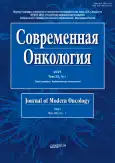Treatment of metastatic hepatocellular carcinoma with lenvatinib. Case report and literature review
- Authors: Menshikov K.V.1,2, Sultanbaev A.V.2, Akhmetgareeva K.T.1, Lipatov D.O.1
-
Affiliations:
- Bashkir State Medical University
- Republican Clinical Oncological Dispensary
- Issue: Vol 23, No 1 (2021)
- Pages: 156-161
- Section: CLINICAL ONCOLOGY
- URL: https://journals.rcsi.science/1815-1434/article/view/70477
- DOI: https://doi.org/10.26442/18151434.2021.1.200785
- ID: 70477
Cite item
Full Text
Abstract
Hepatocellular carcinoma (HCC) or liver cancer is the most common primary malignant tumor of the liver, which is characterized on the first place by a poor prognosis. HCC was diagnosed in 92 patients (62.6%) in 2019 and the period from January to April 2020 in the Republic of Bashkortostan, and among them, 68.47% had stage IV cancer. International professional guidelines suggest screening for early HCC detection. Systemic drug therapy is the treatment of choice for inoperable HCC according to professional guidelines. Inhibition of the VEGF pathway is one of the current methods of therapy for advanced HCC. Lenvatinib is a tyrosine kinase inhibitor for the treatment of advanced HCC that is not subject to local interventions. This article provides a description of a clinical case of successful treatment of a 67-year-old patient with advanced hepatocellular carcinoma. He was appointed for targeted therapy with lenvatinib for HCC that was not subject to local interventions, which led to long-term stabilization. There was a positive trend in the patient’s condition from the first weeks of therapy. The working capacity was restored. The therapy showed a satisfactory tolerability profile.
Keywords
Full Text
##article.viewOnOriginalSite##About the authors
Konstantin V. Menshikov
Bashkir State Medical University; Republican Clinical Oncological Dispensary
Author for correspondence.
Email: kmenshikov80@bk.ru
ORCID iD: 0000-0003-3734-2779
Cand. Sci. (Med.)
Russian Federation, Ufa; UfaAleksandr V. Sultanbaev
Republican Clinical Oncological Dispensary
Email: rkodrb@yandex.ru
ORCID iD: 0000-0003-0996-5995
Cand. Sci. (Med.)
Russian Federation, UfaKamila T. Akhmetgareeva
Bashkir State Medical University
Email: dr.camilaakhmetgareeva@gmail.com
ORCID iD: 0000-0003-0773-1239
Graduate Student
Russian Federation, UfaDanila O. Lipatov
Bashkir State Medical University
Email: lipatov911@gmail.com
ORCID iD: 0000-0002-3193-9008
Student
Russian Federation, UfaReferences
- Torre LA, Siegel RL, Elizabeth M. Ward and Ahmedin Jemal. Global Cancer Incidence and Mortality Rates and Trends – An Update. Cancer Epidemiol Biomarkers Prev 2016; 25: 16–27.
- Jemal A, Ward EM, Johnson CJ, et al. Annual Report to the Nation on the Status of Cancer, 1975–2014, Featuring Survival. J Natl Cancer Inst 2017; 109 (9).
- Bray F, Ferlay J, Soerjomataram I, et al. Global cancer statistics 2018: GLOBOCAN estimates of incidence and mortality worldwide for 36 cancers in 185 countries. CA Cancer J Clin 2018; 68: 394–424.
- Состояние онкологической помощи населению России в 2019 году. Под ред. А.Д. Каприна, В.В. Старинского, А.О. Шахазадовой. М.: МНИОИ им. П.А. Герцена – филиал ФГБУ «НМИЦ радиологии» Минздрава России, 2020 [The state of cancer care for the population of Russia in 2019. Ed. AD Kaprina, VV Starinsky, AO Shahazadova. MNIOI them. PA Herzen is a branch of the Federal State Budgetary Institution «National Medical Research Center of Radiology» of the Ministry of Health of Russia. Moscow, 2020 (in Russian)].
- Ахметгареева К.Т., Липатов О.Н., Меньшиков К.В., Султанбаев А.В. Заболеваемость первичным раком печени в Республике Башкортостан. В кн.: Белые ночи 2020. Тезисы VI Петербургского международного онкологического форума. СПб., 2020; с. 22 [Akhmetgareeva KT, Lipatov ON, Menshikov KV, Sultanbaev AV. The incidence of primary liver cancer in the Republic of Bashkortostan. In the book: White Nights 2020. Abstracts of the VI St. Petersburg International Oncological Forum. Saint Petersburg, 2020; p. 22 (in Russian)].
- Tseng C-H, Hsu Y-C, Chen T-H, et al. Hepatocellular carcinoma incidence with tenofovir versus entecavir in chronic hepatitis B: A systematic review and meta-analysis. Lancet Gastroenterol Hepatol 2020; 5: 1039–52.
- Carrat F, Fontaine H, Dorival C, et al. Clinical outcomes in patients with chronic hepatitis C after direct-acting antiviral treatment: A prospective cohort study. Lancet 2019; 393: 1453–64.
- Kubota N, Fujiwara N, Hoshida Y. Clinical and Molecular Prediction of Hepatocellular Carcinoma Risk. J Clin Med 2020; 9: 3843.
- Pazgan-Simon M, Simon KA, Jarowicz E, et al. Hepatitis B virus treatment in hepatocellular carcinoma patients prolongs survival and reduces the risk of cancer recurrence. Clin Exp Hepatol 2018; 4 (3): 210–6. doi: 10.5114/ceh.2018.78127
- Бредер В.В., Лактионов К.К., Давыдов М.М. Лекарственное лечение гепатоцеллюлярного рака: практические вопросы и решения. Медицинский совет. 2017; 14: 11–23 [Breder VV, Laktionov KK, Davydov MM. Lekarstvennoe lechenie gepatotselliuliarnogo raka: prakticheskie voprosy i resheniia. Meditsinskii sovet. 2017; 14: 11–23 (in Russian)]. doi: 10.21518/2079-701X-2017-14-11-23
- Kieran MW, Kalluri R, Cho YJ. The VEGF pathway in cancer and disease: responses, resistance, and the path forward. Cold Spring Harb Perspect Med. 2012; 2.
- Carlomagno F, Anaganti S, Guida T, et al. BAY 43-9006 inhibition of oncogenic RET mutants. J Natl Cancer Inst 2006; 98 (5): 326–34.
- Llovet JJM, Ricci S, Mazzaferro V, et al. Sorafenib in advanced hepatocellular carcinoma. N Engl J Med 2008; 359 (4): 378–390.
- Kudo M, Finn RS, Qin S, et al. Lenvatinib versus sorafenib in first-line treatment of patients with unresectable hepatocellular carcinoma: a randomised phase 3 non-inferiority trial. Lancet 2018; 391: 1163–73.
- Vogel A, Qin S, Kudo M, et al. Health-Related Quality of Life (HRQOL) and Disease Symptoms in Patients with Unresectable Hepatocellular Carcinoma (HCC) Treated with Lenvatinib (LEN) or Sorafenib (SOR). Ann Oncol 2017; 28 (Suppl. 5): v209–v268. doi: 10.1093/annonc/mdx369.002.
Supplementary files












